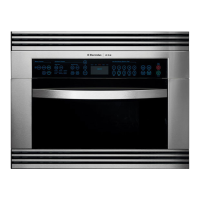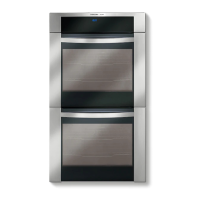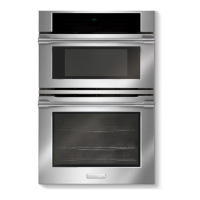13
E30SO75ESS
TROUBLESHOOTING GUIDE
Never touch any part in the circuit with your hand or an uninsulated tool while the power supply is connected.
When troubleshooting the microwave oven, it is helpful to follow the Sequence of Operation in performing the checks. Many
of the possible causes of trouble will require that a specific test be performed. These tests are given a procedure letter which
will be found in the "Test Procedure "section.
IMPORTANT: If the oven becomes inoperative because of a blown monitor fuse, check the monitor switch, relay (RY1)
primary interlock relay (RY2), door sensing switch and secondary interlock switch before replacing the
monitor fuse. If the monitor fuse is replaced, the monitor switch must also be replaced. Use part FFS-
BA033WRKZ as an assembly.
IMPORTANT: Whenever troubleshooting is performed with the power supply cord disconnected. It may in, some cases,
be necessary to connect the power supply cord after the outer case has been removed, in this event,
1. Disconnect the power supply cord
2. Remove the outer case cabinet, referring to "OUTER CASE CABINET REMOVAL".
3. Open the door and block it open.
4. Discharge high voltage capacitor.
5. Remove the back plate from the oven, referring to "BACK PLATE REMOVAL".
6. Disconnect the leads to the primary of the power transformer.
7. Ensure that the leads remain isolated from other components and oven chassis by using insulation tape.
8. After that procedure, reconnect the power supply cord.
When the testing is completed
1. Disconnect the power supply cord, and then remove outer case.
2. Open the door and block it open.
3. Discharge high voltage capacitor.
4. Reconnect all leads removed from components during testing.
5. Reinstall the outer case (cabinet) and theback plate.
6. Reconnect the power supply cord after the outer case and the back plate are installed.
7. Run the oven and check all functions.
ing operation is selected by the control unit.
Microwave Cooking:
Damper is in the open position, because a portion of cooling
air is channelled through the cavity to remove steam and
vapors given off from the heating foods. It is then exhausted
at the top of the oven cavity into a condensation compartment.
Convection, Preheat, Speed Grill, Speed Roast, Speed
Bake, or all cooking modes which use the top / side
heating elements:
Damper is in the closed position, so that no hot air will be
allowed to leak out the oven cavity.
Damper Operation
1. When power supply cord is plugged in:
1-1. When power supply cord is plugged in, a signal is
sensed in the control unit, and operates shut-off
relay (RY4).
1-2. Contacts of shut-off relay (RY4) close, the damper
motor is energized, opening the damper door.
1-3. When the damper is moved to the open position by
the damper cam the damper switch is opened (OFF
position).
1-4. The signal from damper switch is re-sensed in the
control unit and shut-off relay (RY4) is turned off.
1-5. The 240 volts A.C. to the damper motor is removed
and the motor turns off.
2. When oven is microwave cooking:
Damper is in the open position.
3. When oven is convection cooking:
3-1. Damper motor is energized by touching the
convection, temperature and START pads.
3-2. When damper is in the closed position (damper
switch is ON), its signal is sensed by the control unit,
and shut-off relay (RY4) is de-energized.
3-3. The damper is held in the closed position during the
convection cooking operation.
3-4. At the end of the convection cooking, if the cavity air
temperature is below 250
ο
F, shut-off relay (RY4) is
energized, and the damper is returned to the open
position.
NOTE: If the damper door is not in the proper position,
closed during convection or open during
microwave, the control unit will stop oven
operation after 1 minute.

